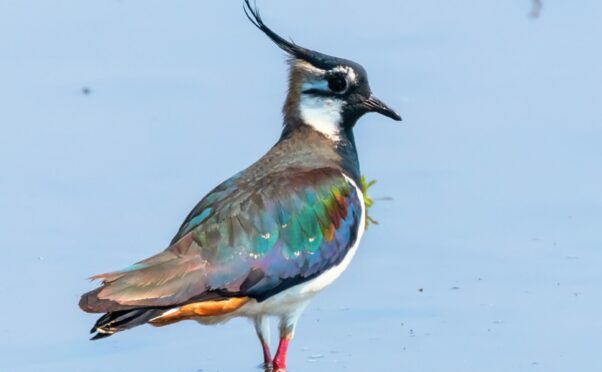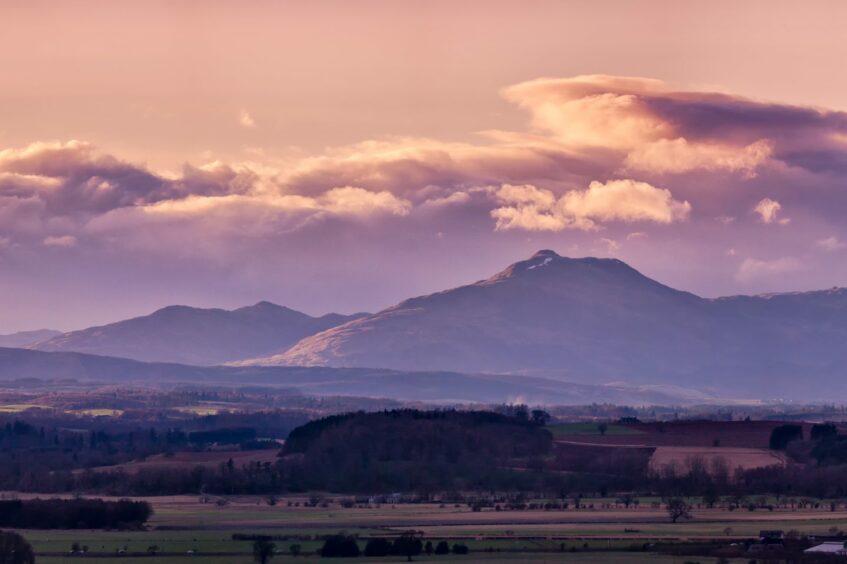
Still snowing up there. The mountains of my workaday skyline were posted missing in the clouds. I always miss Ben Ledi most because it is the lynchpin that holds in place a curving sweep of mountains from Ben Lomond to Ben Vorlich.
From Stirling, it’s what the rampart of the Highlands looks like. Beyond it, heading north, there is scarcely a scrap of flat land between the Pass of Leny and Orkney.
Ben Ledi is pyramid-shaped from the Carse just to the west of Stirling, and there are those who make stab-in-the-dark guesses at the origins of mountain names and who swear it means Mountain of God. Given the oldest names in the land tend to be rivers, and the river at its feet is the Leny, it is a more reasonable to suggest the origin of the mountain’s name is the same as the river’s.
All we need to do, then, is find out what Leny means. Given that “linn” is a waterfall or a narrow gorge with a waterfall, and the Leny has a singularly impressive one – the Falls of Leny no less – I’m aiming my stab in that direction.
Whatever the rights and wrongs of it, it’s a good game at the very least – especially on the kind of December day when the mountain is posted missing.
Being a sensitive soul who leans heavily on familiar landscapes both for a living and as a way of life, the hour is somehow less fulfilling when the mountain is absent, when the land is shorn of its defining focal point. But distractions were manifest.
Birds were on the move everywhere, moving in on the snowy, stubbly fields in huge numbers. The fieldfare and redwing flock appeared to have doubled in size in just a few days and there were uncountable masses of smaller birds.
Everything on the ground faced into the north-east wind. Everything that flew came in low over the hedges and reached a point in the field where they would wheel 90 degrees, stall and land, all facing the same way as the rest.
There was a frantic air to the feeding, and it happened between brutal showers when the sky blackened, the wind and the wind-chill picked up, and everything bolted for cover at the last moment.
The weather was restless, the sky was restless, the birds were restless. The land seethed. The sun shone and vanished, shone and vanished.
I sat in the car. I had the niggling feeling I should be doing more, but this was just one more day when stillness served me best.
As a shower thudded across the fields, the hedge five yards away filled up with tree sparrows and linnets. They burrowed deep inside and the hedge throbbed with their torrents of voices for every moment of the deluge. Then the sky lightened, the sun stole out, the wind eased and they were gone, leaving a suddenly eerie silence.
Sun and wind started to bore into mountain clouds, baring hill shoulders but not clearing the summits. Geese piled in, mostly pink-footed, adding to the mayhem. A mob of rooks drifted over, sounding like heavy agricultural traffic, paused to fire dozens of dummy-run assaults at a solitary kestrel on a fence post. We – the kestrel and I – tired of them and headed west.
Out near Flanders Moss, there were odd shapes in the field across the road. They looked like sods of earth where the snow might have melted – except that the snow had not melted.
The field had been partly ploughed before the snow came, and the shapes lay in the hollows that had been partly filled in with snow. None of them moved. What snapped into focus was a flock of lapwings. But they were so hunkered down only the broad curves of their backs and slim curves of their crests showed.
Newly arrived on migration, I thought, in which case, they had migrated six weeks early. Global warming works in mysterious ways. The mountain was clear, brilliantly lit, aglow with snow and sunlight, almost yellow, almost gold. It is a particular joy of intimate knowledge of a mountain that you carry around with you a four-season awareness of all its moods in all its seasons.
Ben Ledi in my mind is like that, so I can contrive from that suddenly glittering midwinter sculpture, spotlit from the bird-strewn valley of the Carse, not just the knowledge of what that moment looks and feels like up there, but also something like its antithesis. What came to mind, with the motionless lapwings on their couches of snow and the re-emergence of the mountain from its day-long shroud, was the north shoulder of the mountain just below the summit in midsummer.
I developed the habit of climbing the mountain through summer evenings and coming down through the late dusk. I was never much of a summit lingerer, for summits are where people gather and wildlife steers clear. I had been warm and still for half an hour – the only people I’d met on the way up were going down – and it’s fair to say I was mildly intoxicated by the situation.
These ridges of Ben Ledi are where you are finally absorbed beyond the ambiguities of the Highland Edge, the mountain frontier, where you are immersed in your head and your heart in the unfurled Highlands, and north and west they go on forever.
A dowdy brown bird appeared on a heathery outcrop about six feet away, roughly the size of a newly-fledged song thrush but not one, so a newly-fledged what?
It needed help. Where was the parent bird? The answers arrived fussily, flying in from the south while I was looking west. The fledgling had perched with surprising judgment for one so young, for it had chosen a particularly prolific colony of blaeberries, but it was deficient in picking technique.
The parent bird was as unconcerned by my presence as its offspring. There are few more brazen adventurers on the open hill than a ring ouzel.
For the next 10 minutes I watched the adult cram its fledgling and itself with blaeberries. The diagnostic white crescent of its breast was stained purple. How often do you suppose a high summer ring ouzel has been mistaken for an ornithological rarity on account of its purple bib?
The sun touched the mountains in the north-west and fell behind them, but there would be light in the sky for hours yet and light of a kind in the north all night.
There are many forms of contentment within the compass of keeping nature company. There are few more profound than to sit high and warm and still, and watch the Highland landscape bare its soul to the forces of night.
Back in the here and now of my mid-December mid-afternoon, I wondered if lapwing knew ouzel, if their paths ever crossed, if each ever wondered about the habitat of the other.
What I knew for certain was that, thanks to the better part of 50 years in the company of this singular mountain, I could bring them together in a single moment, more than 2,500 feet apart in altitude and quite a few years apart in time. My debt to the mountain is a big one.

Enjoy the convenience of having The Sunday Post delivered as a digital ePaper straight to your smartphone, tablet or computer.
Subscribe for only £5.49 a month and enjoy all the benefits of the printed paper as a digital replica.
Subscribe
